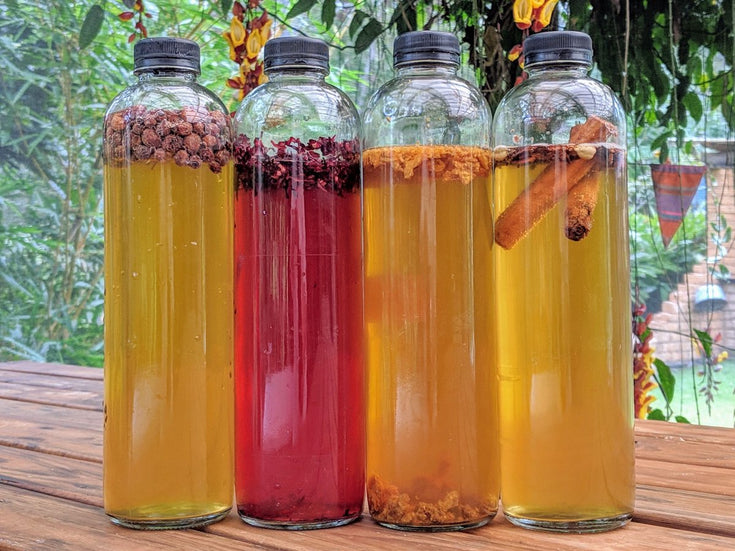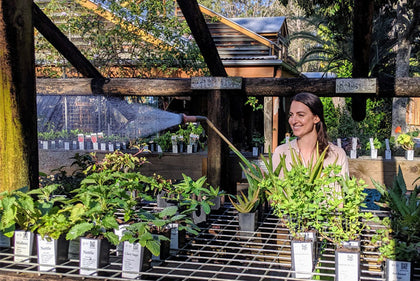Herbal Kombucha Recipes

This week I am following up on some more information we shared for Herb Awareness. I did a talk on using herbs in kombucha. I will cover some of the topics discussed.
- What is Kombucha?
- The Basic Recipe
- Can you use herbs in the primary fermentation?
- Secondary Fermentation
- Herbs and fruit recipes
- Tips and Troubleshooting
What is Kombucha?
Kombucha is a fermented drink made from sweetened tea and a SCOBY (symbiotic culture of bacteria and yeast). It's known for its tangy, slightly sweet flavour. Fermented foods including Kombucha help improve your gut microbiome.
During fermentation, the SCOBY consumes the sugars in the tea, producing organic acids, vitamins, enzymes, and probiotics.
The result is a slightly fizzy, sour, and sweet beverage.
The fermentation process usually takes 1-2 weeks.
During a second fermentation, Kombucha can be flavoured with fruits, herbs, or spices.
The final product contains trace amounts of alcohol due to the fermentation process.
The Basic Kombucha Recipe
Primary Fermentation
What you need:
To make one litre
To make one litre
- Jar: 1+ litre capacity
- Jug: 1+ litre capacity
- Water: 900ml
- Sugar: 1⁄4 cup
- Tea: 2 tsp loose black tea ( for the herb ones I used 2 heaped teaspoons instead of the black tea)
- Starter liquid: 100ml
- Scoby - a piece of your last one or one that someone has given you
- Coffee filter paper or finely woven cloth to cover the top of the jar
How to do it:
- Heat 300ml of water, add sugar, stir until dissolved.
- Add tea to sugar water and steep for 10 minutes
- Add the 600ml remaining water, cool to room temp.
- Strain loose tea into Jar
- Add SCOBY and starter liquid.
- Cover with a breathable lid.
- Start checking your kombucha after 7 days to test flavour. It can take up to 30 days in colder weather.
- Once the kombucha is ready you can pour off 900ml leaving 100ml for your next batch.
- You can now use the 900ml of fermented kombucha to drink straight or you can use it to do a second fermentation.
FAQ: Can You Use Herbs in the Primary Fermentation?
The primary fermentation of Kombucha is most commonly made with black tea or green tea.
Being a herby person, I wondered why I couldn’t use herbs instead of black tea in the first primary fermentation. Searches online kept coming up with you can’t use herbs as they will weaken or kill the SCOBY.
I searched what is in black tea that feeds the scoby and came up with tannins, polyphenols and nitrogen. Many herbs contain these three compounds.

I decided to try some different dried herbs on my shelf to see how they go.
2/02/23 - I made four 1-litre jars each made with the recipe above. I did use a SCOBY from my 4-litre Kombucha. I cut the scoby into four portions and used 100ml of the already-made kombucha as the starter liquid for each jar.
- Herb robert - 2 heaped tsp, 1/4cup sugar, 900ml water, 100ml starter liquid and ¼ of my large SCOBY
- Epilobium - 2 heaped tsp, 1/4cup sugar, 900ml water, 100ml starter liquid and ¼ of my large SCOBY
- Tulsi - 2 heaped tsp, 1/4cup sugar, 900ml water, 100ml starter liquid and ¼ of my large SCOBY
- Black tea - 2heaped tsp, 1/4cup sugar, 900ml water, 100ml starter liquid and ¼ of my large SCOBY
All were made the same way.
The black tea one was the Control Jar, so I could compare how each one went up against the black tea.
I have made 4 batches of each since then, and I am happy to say they are all doing well at this stage.
I love the subtle clove taste of the Tulsi one the best. But all of them have been suitable bases for the second ferment.
I will continue to make them all over the next few months to see if any of them weaken over time.
Secondary Fermentation
After anywhere between 7 days and 30 days depending on the weather. It likes warm weather. It can then be strained and herbs and fruits added to do a second fermentation, this adds flavour and sometimes fizz depending on the sugar content of your additives.
Flavour your kombucha by directly adding fruits, juices, herbs, and spices into bottles or infusing them in another jar before bottling. If using juice, start with a 10%-20% juice-to-kombucha ratio. For herbs and fruits, experiment for desired taste. After a few days of infusing, strain and bottle.
Flavour your kombucha by directly adding fruits, juices, herbs, and spices into bottles or infusing them in another jar before bottling. If using juice, start with a 10%-20% juice-to-kombucha ratio. For herbs and fruits, experiment for desired taste. After a few days of infusing, strain and bottle.

Below are some herby blends that I have used for 2nd ferments.
To 900ml of strained kombucha add any one of the following combinations.
Asian spice
- 1 cup chopped fresh lemongrass
- 8 cm piece of sliced ginger
- 8 cm piece of sliced turmeric
- 10 black peppercorns
Heart Love
- ¼ cup heart love tea
- ¼ cup hawthorn berries
- ¼ cup rose petals
- 3 large slices of dried tangerine
Apple Chamomile
- 1 small green apple or ½ large
- ¼ cup dried chamomile flowers
- Sprig of sage (6 leaves)
Rosy Ginger
- 2 tbsp dried rosella
- 10 slices ginger
Chai spice
- 2 cinnamon sticks
- 10 cardamom pods
- 8 cloves
- 2 star anise
- 1 Vanilla pod sliced in half lengthways
We love to pour some of the strained flavoured kombucha into a glass and top it with soda water…so refreshing.
Producing Fizz
To produce fizz, ensure some sugar is still available for yeast after bottling. Add honey, sugar, sweet fruits or juices if needed. Leave bottles at room temperature for a few days before storing in the fridge.
Tips & Troubleshooting
- Keep SCOBY in a cool, dark place away from smoke.
- Always cool tea before adding SCOBY and starter tea.
- Kombucha tasting like vinegar is often due to over-fermentation.
- Your SCOBY will move during fermentation, usually with the freshest one at the top.
Microbial and Nutritional Composition
Depends on factors like the type of tea used, sugar, water quality, temperature, and length of fermentation. Usually contains a variety of bacteria and yeast, organic acids, vitamins, minerals, amino acids, sugars, and antioxidants. The alcohol content is between 0.5% - 3.0% depending on the amount of sucrose used and the time of fermentation.
Remember
This process can vary between different batches based on many factors. Keep an eye on your brew, be patient, and make adjustments as needed.




